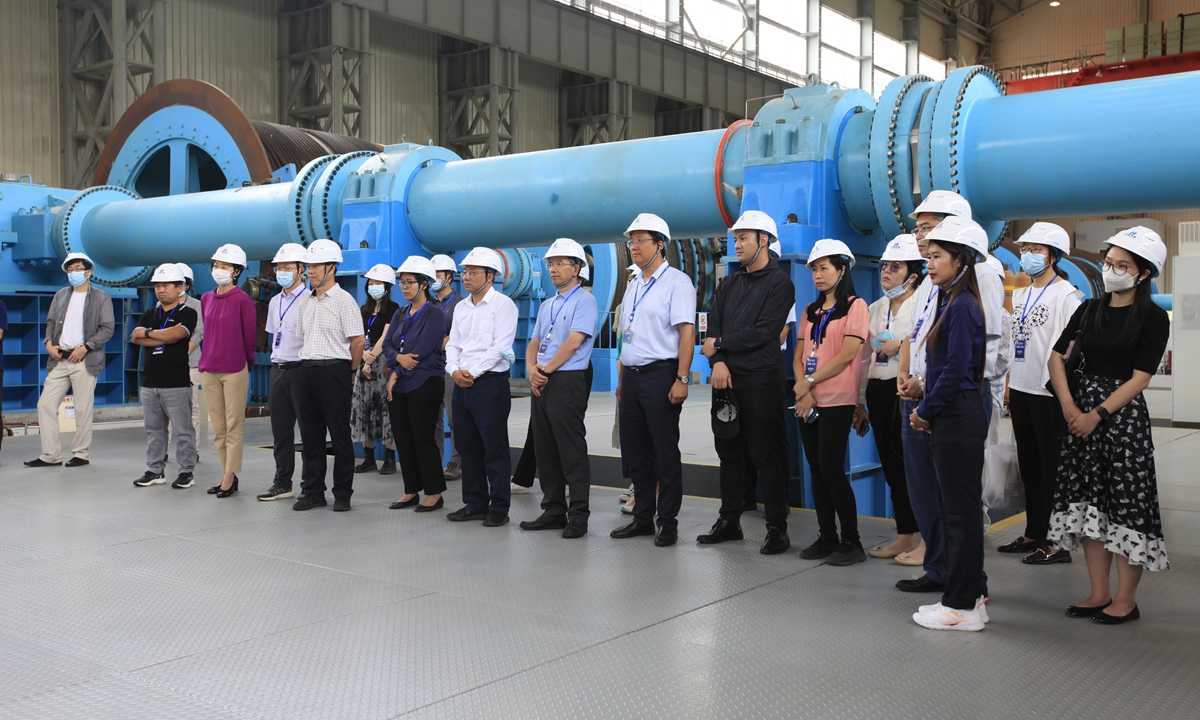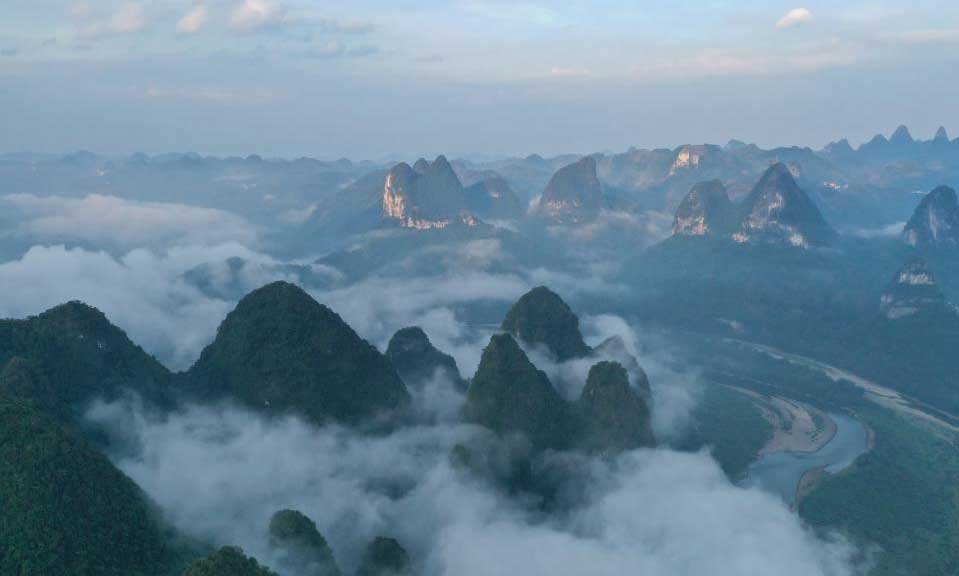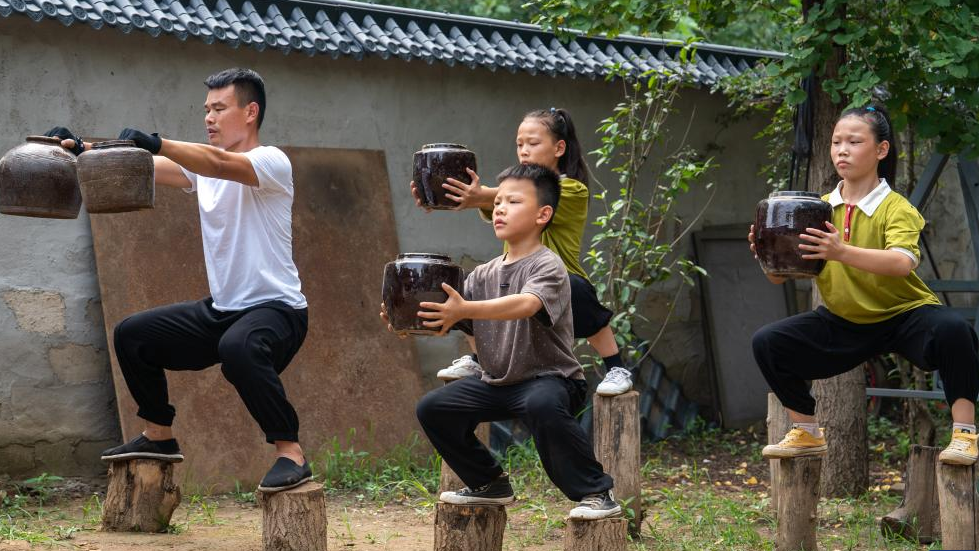Responsible neighbor: China maintains water release to downstream Mekong countries despite extreme heat, drought
Despite extreme heat, drought, and water shortages that saw an obvious reduction in rainfall in Lancang River, China has nevertheless maintained water supply to the lower reaches of the Mekong River, the Global Times recently learned from the operator of key hydropower stations on China's Lancang River, on the upper reaches of the Mekong River which connects six countries.
Experts warn that extreme weather and droughts will possibly be the biggest challenge to Lancang-Mekong water resources currently, while some foreign countries outside the region such as the US take the chance to sow seeds of discord or hype up conflicts among the six riparian countries along the Lancang-Mekong River.
The envoys and representatives of the Mekong countries have called for enhanced cooperation and information sharing to bring the Lancang-Mekong Cooperation (LMC) mechanism to an elevated level despite Western provocation of ties.
Challenges in the basin
Climate change has been an increasing threat in the Lancang-Mekong River Basin with concerns growing over more frequent extreme weather negatively impacting the livelihoods of the millions who rely on the river's natural resources. Rising temperatures and changes in intensity and frequency of rainfall, river flow, floods and droughts are dangerous for homes, infrastructures, crops, and fisheries.
"From January to August, the Lancang River Basin suffered from extreme drought as the water flow decreased significantly. The natural water flow of the Lancang River in China decreased by more than 20 percent. The decrease of water flow peaked in July and August, as more than 50 percent of the precious resource almost disappeared," the Huaneng Lancang River Hydropower Inc which operates the Jinghong Hydropower Station that is close to the China-Laos border told the Global Times on Thursday.
A recent scientific study revealed that the Lancang-Mekong River basin tends to experience a wetter rainy season and a drier intermittent season with rising temperatures coinciding with climate change, the study's researcher Liu Hui, from the China Institute of Water Resources and Hydropower Research, told the Global Times, calling for more effective strategies to enhance food and drinking water security in the basin.
Downstream countries have also experienced more extreme weather events this year. In Vietnam, for example, since the beginning of this year, natural weather phenomena have become increasingly unpredictable, with unseasonal rains and flooding accompanied by thunderstorms, strong winds, and storms, local media reported.
China has similarly suffered such crises in recent days as the Yangtze River Basin, for instance, is in grapples with a severe drought with sizzling temperatures for more than two months and the lowest rainfall recorded in six decades. Drought conditions have also persisted across much of Southwest China's Sichuan Province for more than two months.
Common interests always priority
Even in the face of significantly reduced natural precipitation, the cascade power stations along the Lancang River still gives full play to the regulation of water flow downstream to guarantee that basic water needs are met.
According to data provided to the Global Times by the Huaneng Lancang River Hydropower Inc., the actual outbound flow of the Jinghong reservoir from January to August increased by 410 cubic meters per second, an increase of more than 30 percent of the natural flow, showing how the hydropower station's giving full play to its regulating role and effectively guaranteeing downstream water demands for shipping, ecology, and water supply.
According to data published on the Mekong River Commission website, the water levels at the sections of Vientiane and Stung Treng on the mainstream of the Mekong River have remained at a normal level and have not been affected by drought, which experts said is a benefit of generous water releases from China.
Notably, the Jinghong reservoir, as an important power source in China, has given up participating in hydropower supply and emergency tasks nationwide in peak time, despite the current intense power shortage in Southwest China, but gives priority to ensuring that its outbound flow strictly meeting the basic needs of Mekong River shipping and other activities in the upcoming dry season starting from November, the Global Times learnt from the company.
This means that the Jinghong Hydropower Station does not fully exert its function for domestic electricity demand, but tries its best to help the downstream to cope with possible droughts and avoid further transference of upstream challenges to the downstream, Hao Zhao, secretary general of the Lancang-Mekong Water Resources Cooperation Center, told the Global Times.

The function of Jinghong reservoir during the extreme drought (Source: Huaneng Lancang River Hydropower Inc)
Since 2016, the cascade power stations on the Lancang River have played a crucial role in flood control and drought relief along the Lancang-Mekong River.
The water flow of the river reach below the Jinghong Hydropower Station now is generally enough for navigation even in the dry season, which was not possible before the Lancang cascade hydropower stations were built.
During the dry season between November 2021 and May 2022, the inflow to the Jinghong Hydropower Station was only 831 cubic meters per second, while the station released as much as 1,431 cubic meters per second, about 72 percent higher than the natural flow, which fully demonstrates the dam's efficacy.
China's efforts to enable downstream countries to relieve extreme weather and electricity strains are also reflected in China's support of dam maintenance downstream.
Under the framework of the LMC mechanism, Chinese technical experts trained expertise teams in Laos, Thailand, and Vietnam on dam inspection and safety checks.
China has also helped Laos build a national water resources information and data center to provide timely and reliable water data to help in flood control and drought relief, which has been highly recognized by the Laotian leader.
During a recent four-day trip to hydropower stations along the Lancang River in Yunnan Province, diplomats and representatives from Cambodia, Laos, Myanmar, Thailand, and Vietnam learnt about the touching stories that are a common theme for both upstream and downstream countries in their joint efforts to prevent floods and droughts, and applauded Chinese efforts in building a community with a shared future of Lancang-Mekong countries in a joint agreement reached at the Seventh LMC Foreign Ministers' Meeting held in Bagan, Myanmar, on July 4, 2022.
Zin Mar Htwe, Charge d'Affaires of the Myanmar Embassy in China, thanked China for continuously sharing hydrological information with the Mekong countries and offering support for projects funded by the LMC Special Fund.
Transparency and information sharing highlighted
The West's insinuation that "China's deep reluctance to share information about the [upstream] dams is causing tensions in downstream region" has never stopped.
But the fact is China is ramping up efforts to enhance transparent data sharing.
To contribute to the collaborative efforts, China has made good on its promise to share year-round hydrological data of the Lancang River with the launching of an online information sharing platform on November 30, 2020.
The platform aims to provide reliable data and early warning services related to floods and droughts. The data was mainly collected by the Yunjinghong Hydrological Station on the Lancang River and the Man'an Hydrological Station on its tributary. The Global Times reporter visited the Yunjinghong Hydrological Station on Thursday, and found out that the station has been using state-of-the-art technology such as side minesweepers to detect water levels and flows since 2019, combined with manual checks to ensure the accuracy of data collected.
Taking the Yunjinghong Hydrological Station as an example, China shares real-time data with downstream countries twice a day at 8 am and 8 pm. The information is critical for downstream countries, the head of the station told the Global Times.
The collected data is simultaneously shared to downstream state water resources authorities and also posted on the aforementioned information sharing platform. "The daily update has never been interrupted, and never been misreported. Downstream countries also appreciate China's efficiency and sincerity in information sharing," Hao noted.

Diplomats and representatives from Mekong countries visit the Jinghong Hydropower Station in Yunnan Province in August 2022. Photo: Hu Yuwei/GT
The US has, for many years, blamed China for the downstream drought by drawing unreliable and inaccurate conclusions from remote sensing satellite data and analytical models. Therefore, it is more important to introduce more digital technology and more mature models under the LMC mechanism to provide and share reliable data to refute such false accusations, Guo Yanjun, Director of the Institute of Asian Studies at China Foreign Affairs University in Beijing, told the Global Times.
In a White House-released action plan on global water security published in June, the US vowed to use data-driven approaches in decision-making related to international waters. The scientific, technical agencies and the US Intelligence Community would be used during all stages of policymaking, diplomacy, and programming, said the plan.
Extreme weather and drought may be the biggest challenge to the Lancang-Mekong water resources cooperation. While, the US and some countries outside the region may grab the chance to create conflicts and stir up disputes among the Lancang-Mekong countries. China and other LMC countries should try their best to release details and results of close cooperation, and welcome international participation to clarify rumors, Zhai Kun, an expert on the Mekong region with the School of International Studies at the Peking University, told the Global Times.
"This year has been particularly difficult for sustainable development and governance in the Lancang-Mekong region as it faces multiple challenges, including the COVID-19 pandemic, energy and food crisis brought by the Russia-Ukraine conflict, and the recent drought. These represent potential sources of tension, particularly as the climate changes and water availability becomes less predictable, but also presents opportunities for novel forms of cooperation," said Zhai.
Photos
Copyright © 2022 People's Daily Online. All Rights Reserved.









